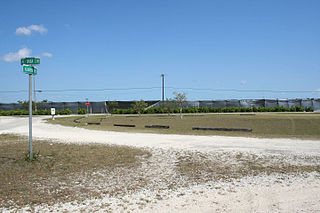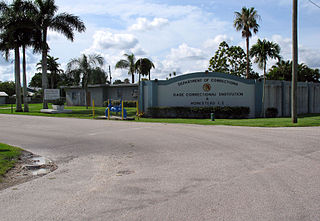
Florida City is a city in Miami-Dade County, Florida, United States and is the southernmost municipality in the South Florida metropolitan area. Florida City is primarily a Miami suburb and a major agricultural area.

Homestead is a city within Miami-Dade County in the U.S. state of Florida, between Biscayne National Park to the east and Everglades National Park to the west. Homestead is primarily a Miami suburb and a major agricultural area. It is a principal city of the Miami metropolitan area, which was home to an estimated 6,012,331 people at the 2015 census.

Kendall is a census-designated place in Miami-Dade County, Florida, United States. At the 2010 census, the area had a population of 75,371.

Richmond West is a census-designated place (CDP) in Miami-Dade County, Florida, United States. The population was 28,082 at the 2000 census.

Coconut Grove, also known colloquially as The Grove, is the oldest continuously inhabited neighborhood of Miami in Miami-Dade County, Florida, United States. The neighborhood is roughly bound by North Prospect Drive to the south, LeJeune Road to the west, South Dixie Highway and Rickenbacker Causeway to the north, and Biscayne Bay to the east. It is south of the neighborhoods of Brickell and The Roads and east of Coral Gables. The neighborhood's name has been sometimes spelled "Cocoanut Grove" but the definitive spelling "Coconut Grove" was established when the city was incorporated in 1919.

The Miami metropolitan area, is the seventh-largest metropolitan area in the United States and the 72nd largest metropolitan area in the world. At 1,279.2 sq mi (3,313 km2) of urban landmass it is one of the most populous urban agglomerations in the world. The City of Miami is the financial and cultural core of the metropolis. The metropolitan area includes the Miami-Dade, Broward, and Palm Beach counties which are the first, second, and third most populous counties in Florida. Miami-Dade, with 2,716,940 people in 2019, is the seventh most populous county in the United States. The three counties together have principal cities including Miami, Fort Lauderdale, Pembroke Pines, West Palm Beach, Hialeah, Hollywood, and Boca Raton. It sits within the South Florida region, which includes the Everglades and the Florida Keys. It is also synonymous with an area known collectively as the "Gold Coast".

The Fruit & Spice Park, formally known as the Preston B. Bird/Mary Heinlein Fruit & Spice Park, is a 37-acre park located in the heart of Redland, Florida and is the only botanical garden of its kind in the United States. This park is operated by Miami-Dade County Parks and Open Spaces Department. The park in itself attracts more than 50,000 visitors a year because of its unique agricultural environment. The garden features more than 500 different types of international exotic fruits, vegetables, herbs, and spices. Visitors are allowed to sample fallen fruits, enjoy lunch at the Mango Cafe, or schedule a tour of the park.
State Road 997, also known as Krome Avenue and West 177th Avenue is a 36.7-mile-long (59.1 km) north–south state highway in western Miami-Dade County, Florida. It runs from State Road 998 in Homestead north across U.S. Route 41 to U.S. Route 27 near Countyline Dragway, just south of the Broward County line. Its main use is as a bypass around the western side of Miami, linking the routes that run southwest, west and northwest from that city. The road passes through newer suburbs in the southern third of its length, while the northern two thirds of the highway traverse the eastern edge of the Everglades.
From the late 1950s to the 1970s, State Road 908 was a 13-mile-long east–west street in southern Miami-Dade County, Florida, USA. Locally, it was known as Southwest 232nd Street, Silver Palm Drive, and Bailes Road. Its western terminus was an intersection with Country Club Road in the Redlands; its eastern terminus was an intersection with Galloway Road midway between Cutler Bay and Black Point. All but 1.3 miles (2.1 km) of SR 908 was on Silver Palm Drive—the section just east of South Dixie Highway was bypassed by using US 1 and Bailes Drive in Goulds.

The Silver Palm Schoolhouse is an historic school in the Silver Palm Historic District within the unincorporated community of Redland, Florida. It is located at Silver Palm Drive and Newton Road. On July 2, 1987, it was added to the U.S. National Register of Historic Places.

Redland, long known also as the Redlands or the Redland, is a historic unincorporated community and agricultural area in Miami-Dade County, Florida, United States, about 20 miles (32 km) southwest of Downtown Miami and just northwest of Homestead, Florida. It is unique in that it constitutes a large farming belt directly adjoining what is now the seventh most populous major metropolitan area in the United States. Named for the pockets of red clay that cover a layer of oolitic limestone, Redland produces a variety of tropical fruits, many of which do not grow elsewhere in the continental United States. The area also contains a large concentration of ornamental nurseries. The landscape is dotted with u-pick'em fields, coral rock (oolite) walls, and the original clapboard homes of early settlers and other historic early twentieth century structures.

South Dade Senior High School is a secondary school in unincorporated Miami-Dade County, Florida, just north of Homestead. It is located on 60 acres (240,000 m2) at the southernmost end of Miami-Dade County.

Dadeland is a commercial district and urban neighborhood similar to an edge city, amid the sprawling metropolitan Miami suburbs of Kendall, Glenvar Heights, and Pinecrest, in the U.S. state of Florida, at the end of the Metrorail line.

August Geiger was one of the most prominent American architects in South Florida from 1905 to the late 1940s. He experimented in Mission, Neo-Renaissance and Art Deco architecture, but is most noted for his works in the Mediterranean Revival style. A number of his works are listed on the U.S. National Register of Historic Places.

Aladdin City is an unincorporated community in Miami-Dade County, Florida, United States. It is located about 20 miles (32 km) southwest of Miami within the unincorporated community of Redland. It is notable as the site of a planned community—similar to Opa-locka, Coral Gables, and Miami Springs, Florida—whose development was snuffed out by the abrupt end of the Florida land boom of the 1920s.

Miami-Dade County is located in the southeastern part of the U.S. state of Florida. According to a 2019 census report, the county had a population of 2,716,940, making it the most populous county in Florida and the seventh-most populous county in the United States. It is also Florida's third largest county in terms of land area, with 1,946 square miles (5,040 km2). The county seat is Miami, the principal city in South Florida.
Silver Palm is an unincorporated community and historic district in Miami-Dade County, Florida, United States. It is located about 20 miles (32 km) southwest of Miami within the unincorporated community of Redland. Formerly a distinct community in the first half of the 20th century, it has now been absorbed into other communities in the region. The Homestead and Redland District directory for 1927-1928 includes the community of Silver Palm. The community name survives in Silver Palm Drive and the Silver Palm Schoolhouse.

Miami-Dade County Public Schools (M-DCPS) is a public school district serving Miami-Dade County, in the U.S. state of Florida. Founded in 1885, it is the largest school district in Florida and the Southeastern United States, and, as of 2020, the fourth largest in the United States, with a student enrollment of 356,086 as of August 30, 2017.

The Dade Correctional Institution is a prison in unincorporated Miami-Dade County, Florida, near Florida City, and south of Homestead, in Greater Miami. It houses adult males. It opened in September 1996. It is a part of the Florida Department of Corrections, and is right next to the Homestead Correctional Institution which houses female inmates.
Sottile Farms was a large farm in South Florida owned by the Sottile family of Miami, and incorporated as South Dade Farms. Sottile Farms was over 30,000 acres and was owned by the Sottile family from 1930 to 1974. Sottile Farms was created by James Sottile, an Italian-American immigrant who was one of 7 Sottile brothers that immigrated to Charleston, SC in the late nineteenth century. The Sottile family is prominent in Charleston, and a local venue, the Sottile Theater, continues their legacy. Prior to creating Sottile Farms, James Sottile owned the Isle of Palms in Charleston, SC. By the time of his death in 1964, James Sottile was one of the richest people in America.
















